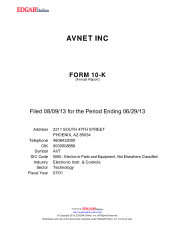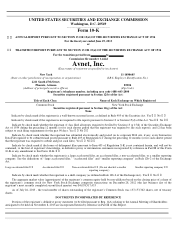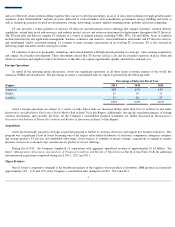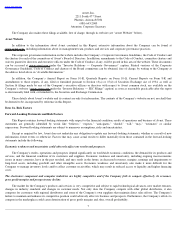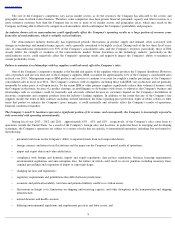Avnet 2013 Annual Report Download - page 10
Download and view the complete annual report
Please find page 10 of the 2013 Avnet annual report below. You can navigate through the pages in the report by either clicking on the pages listed below, or by using the keyword search tool below to find specific information within the annual report.
Table of Contents
The size of the Company's competitors vary across market sectors, as do the resources the Company has allocated to the sectors and
geographic areas in which it does business. Therefore, some competitors may have greater financial, personnel, capacity and other resources or a
more extensive customer base than the Company has in one or more of its market sectors and geographic areas, which may result in the
Company not being able to effectively compete in certain markets which could impact the Company's profitability and prospects.
An industry down
-
cycle in semiconductors could significantly affect the Company's operating results as a large portion of revenues come
from sales of semiconductors, which is a highly cyclical industry.
The semiconductor industry historically has experienced periodic fluctuations in product supply and demand, often associated with
changes in technology and manufacturing capacity, and is generally considered to be highly cyclical. During each of the last three fiscal years,
sales of semiconductors represented over 50% of the Company's consolidated sales, and the Company's revenues, particularly those of EM,
closely follow the strength or weakness of the semiconductor market. Future downturns in the technology industry, particularly in the
semiconductor sector, could negatively affect the Company's operating results and negatively impact the Company's ability to maintain its
current profitability levels.
Failure to maintain its relationships with key suppliers could adversely affect the Company’s sales.
One of the Company's competitive strengths is the breadth and quality of the suppliers whose products the Company distributes. However,
sales of products and services from one of the Company's suppliers, IBM, accounted for approximately 12%
of the Company's consolidated sales
in fiscal year 2013
. Management expects IBM products and services to continue to account for roughly a similar percentage of the Company's
consolidated sales in fiscal year 2014
. The Company's contracts with its suppliers, including those with IBM, vary in duration and are generally
terminable by either party at will upon notice. To the extent IBM or other primary suppliers significantly reduce their volume of business with
the Company in the future, because of a product shortage, an unwillingness to do business with Avnet, or otherwise, the Company's business and
relationships with its customers could be materially and adversely affected because its customers depend on the Company's distribution of
electronic components and computer products from the industry's leading suppliers. In addition, to the extent that any of the Company's key
suppliers modify the terms of their contracts including, without limitation, the terms regarding price protection, rights of return, rebates or other
terms that protect or enhance the Company's gross margins, it could materially and adversely affect the Company's results of operations,
financial condition or liquidity.
The Company's non-
U.S. locations represent a significant portion of its revenue, and consequently, the Company is increasingly exposed to
risks associated with operating internationally.
During fiscal year 2013 , 2012 and 2011 , approximately 63% , 61% and 62%
, respectively, of the Company's sales came from its
operations outside the United States. As a result of the Company's foreign sales and locations, in particular those in emerging and developing
economies, the Company's operations are subject to a variety of risks that are specific to international operations, including, but not limited to,
the following:
8
•
potential restrictions on the Company's ability to repatriate funds from its foreign subsidiaries;
•
foreign currency and interest rate fluctuations and the impact on the Company's reported results of operations;
• import and export duties and value-
added taxes;
•
compliance with foreign and domestic import and export regulations, data privacy regulations, business licensing requirements,
environmental regulations and anti-
corruption laws, the failure of which could result in severe penalties including monetary fines,
criminal proceedings and suspension of import or export privileges;
•
changing tax laws and regulations;
•
regulatory requirements and prohibitions that differ between jurisdictions;
•
economic and political instability, terrorism and potential military conflicts or civilian unrest;
•
fluctuations in freight costs, limitations on shipping and receiving capacity, and other disruptions in the transportation and shipping
infrastructure;
•
natural disasters and health concerns;
•
differing environmental regulations and employment practices and labor issues; and

